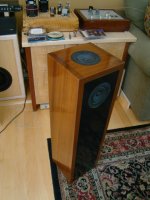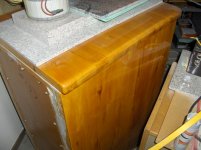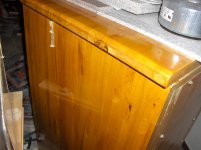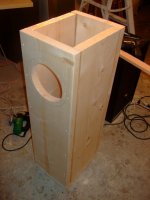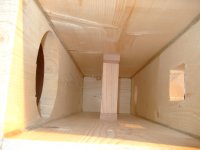I've read lots of topics regarding solid wood for cabinets but still confused.
1. It's said solid wood is easy to warp, well I have build all my furnitures with oak and walnut, so I do have some experience on that and I know it's really ugly when wood warps. But if you age your wood for say one year or more, and if you live in a fairly stable moisture enviroment, I guess it won't be a huge problem, you just have to seal the wood with enough layers of finish, and becareful with the grain orientation.
2. They say solid wood have different acoustic response. Well that's something I really don't know, I'd appreciate some real life experience🙂
Btw I'd like to use walnut or oak(red/white?), or is there a better choice?
I'd like to build a whole 9.2 system( the "9" part): 2 floor standing, 6 small ones and 1 center.
Well I'd be grateful if anyone could suggest some full designs too(I know I shoud only use mature designs at my knowledge level instead of mess it around by myself )
)
Thanks in advance!😛
1. It's said solid wood is easy to warp, well I have build all my furnitures with oak and walnut, so I do have some experience on that and I know it's really ugly when wood warps. But if you age your wood for say one year or more, and if you live in a fairly stable moisture enviroment, I guess it won't be a huge problem, you just have to seal the wood with enough layers of finish, and becareful with the grain orientation.
2. They say solid wood have different acoustic response. Well that's something I really don't know, I'd appreciate some real life experience🙂
Btw I'd like to use walnut or oak(red/white?), or is there a better choice?
I'd like to build a whole 9.2 system( the "9" part): 2 floor standing, 6 small ones and 1 center.
Well I'd be grateful if anyone could suggest some full designs too(I know I shoud only use mature designs at my knowledge level instead of mess it around by myself
 )
) Thanks in advance!😛
Solid wood is seldom used in commercial designs because its just too expensive. I have also always heard the issue about warpage, but that could probably be surmounted with the right wood and aging. I am familiar with piano construction and keys and hammers are made with solid wood (but I have seen hammers warp). I also remember a video on piano construction where they took a large board of solid wood and cut it into 1" wide strips. Each strip was turned 90 degrees and then they were all glued back together, kind of a butcher block approach. This was said to give them long term stability.
Still, in the end solid wood tends to be lighter and higher Q than most veneered MDF. As such it is a slightly inferior material to use, so I wouldn't be real excited about paying a lot more for inferior results.
David S.
Still, in the end solid wood tends to be lighter and higher Q than most veneered MDF. As such it is a slightly inferior material to use, so I wouldn't be real excited about paying a lot more for inferior results.
David S.
Speaking as a cabinetmaker, the logistics of a solid wood cabinet can be overcome. From the standpoint of what speaker dave has illustrated ... not so much. It's hard to defeat woods inherent sound characteristics ... ie its lack of consistency piece to piece.
There is however the alternative of a frame/panel construction which could open up a wide variety of panel configurations and construction techniques to address the various points made by speaker dave. Best of both worlds perhaps.
There is however the alternative of a frame/panel construction which could open up a wide variety of panel configurations and construction techniques to address the various points made by speaker dave. Best of both worlds perhaps.
Is a higher Q, lighter weight material inherently inferior? I would think that a higher Q material would be easier to damp with bracing... but I'm not really an expert in the field.
Either way I would consider a frame and panel construction as puppet recommends. I've never found warping to be a problem when building solid wood cabinets, but I've certainly had trouble with expansion and contraction. Both in opening up joints over time and in trying to screw a drivers frame to a expanding/shrinking piece of wood. Something will give eventually.... so this needs to be addressed. Either an over sized hole in the baffle with bolts, or frame and panel with a plywood panel.
Joe
Either way I would consider a frame and panel construction as puppet recommends. I've never found warping to be a problem when building solid wood cabinets, but I've certainly had trouble with expansion and contraction. Both in opening up joints over time and in trying to screw a drivers frame to a expanding/shrinking piece of wood. Something will give eventually.... so this needs to be addressed. Either an over sized hole in the baffle with bolts, or frame and panel with a plywood panel.
Joe
Cabinet damping
Actually, bracing doesn't "damp" vibrations at all. Bracing does raise the resonant frequency and raise the "Q". If you can get the resonant points out of the band that the cabinet is expected to work over, then that's good. Bracing a subwoofer is good, Bracing a midrange isn't typically very successful...
De-coupling drivers from cabinets helps, as does increasing the mass of the panels with damping panels such as asphalt pads, etc. helps, too.
Actually, bracing doesn't "damp" vibrations at all. Bracing does raise the resonant frequency and raise the "Q". If you can get the resonant points out of the band that the cabinet is expected to work over, then that's good. Bracing a subwoofer is good, Bracing a midrange isn't typically very successful...
De-coupling drivers from cabinets helps, as does increasing the mass of the panels with damping panels such as asphalt pads, etc. helps, too.
Last edited:
Is a higher Q, lighter weight material inherently inferior? I would think that a higher Q material would be easier to damp with bracing... but I'm not really an expert in the field.
Joe
You are half right. Lighter is actually good if you intend to add damping as the damping to mass ratio can be better. Higher Q generally means less internal loss and so more loss needs to be added to get to low output at each resonance.
I agree with Jplesset about bracing vs. damping, etc.
David S.
I used real wood in a big bass guitar horn I built
ok, softer pine or spruce wood
some part of it were plywood or MDF
whatever I could find
made some real weird crack sounds sometimes 😀
nah, I won't do that again
but I guess the box corners could be real beautiful with that wood
I think you may find other speaker designs with that
there are several ways to do it, and some look better than others
ok, softer pine or spruce wood
some part of it were plywood or MDF
whatever I could find
made some real weird crack sounds sometimes 😀
nah, I won't do that again
but I guess the box corners could be real beautiful with that wood
I think you may find other speaker designs with that
there are several ways to do it, and some look better than others
I used real wood in a big bass guitar horn I built
ok, softer pine or spruce wood
some part of it were plywood or MDF
whatever I could find
made some real weird crack sounds sometimes 😀
nah, I won't do that again
I was sitting next to a large subwoofer once when it let out a big CRACK.
Sounded like a gunshot. I nearly had a heart attack.
It was a split that ran down one side and up another edge. It was an MDF cabinet but with solid corners to join the panels and allow for a nice looking radius.
It was mid winter in Binghamton and probably pretty dry.
David S.
You need to think about expansion and contraction. Wood grows across the grain when the humidity goes up, and shrinks back when the air is drier. You can't stop it. Try this.... solid wood sides top and bottom with the grain going around the box. Then use plywood or MDF for the front and back. This avoids grain conflict.
Evan
Evan
Attachments
Yep exactly, that's what I would do, and if front/back panel were attached with bigger screw holes like tabletops, I can use solid wood too, just need to balance--not too loose to vibrate, nor too tight to crackYou need to think about expansion and contraction. Wood grows across the grain when the humidity goes up, and shrinks back when the air is drier. You can't stop it. Try this.... solid wood sides top and bottom with the grain going around the box. Then use plywood or MDF for the front and back. This avoids grain conflict.
Evan
Speaking as a cabinetmaker, the logistics of a solid wood cabinet can be overcome. From the standpoint of what speaker dave has illustrated ... not so much. It's hard to defeat woods inherent sound characteristics ... ie its lack of consistency piece to piece.
There is however the alternative of a frame/panel construction which could open up a wide variety of panel configurations and construction techniques to address the various points made by speaker dave. Best of both worlds perhaps.
Frame and panel? Do you mean like furniture? I do use frame and panel for my pie-safe side panels, but for cabinet? I don't know how to prevent the panel from vibrating, and I think it would be very hard to make it air tight.Or is it a totally different method than furniture?
Yep ... typical frame and panel affair. Think outside the box for a minute.Frame and panel? Do you mean like furniture? I do use frame and panel for my pie-safe side panels, but for cabinet? I don't know how to prevent the panel from vibrating, and I think it would be very hard to make it air tight.Or is it a totally different method than furniture?
1. Forget about trapping the panel in a groove. Think rabbit for the panel to flush up against.
2. Anything as simple as a wood toggle can hold the panel in place from the back side. Make the panel oversized ... rabbit it over the frames back side and screw it off. A bead of sealant around the panel to the frame (inside now) completes the seal and vibration concerns.
3. The panel can be made out of anything ... veneered plywood (1/4") laminated to another blank with damping in between (felt, vinyl, etc). You'd have to fabricate a simple cold press to laminate the panels. Clamping between a few sheets of 3/4" plywood should work just fine. Panels like this won't shrink away from the frame. I've made panels using solid stock resawn to 1/4" or under. Lay them up the same way ... access to a widebelt sander is almost mandatory though. If you do something like this any number of designs can be expressed in the lay up. Booked pieces ... diamond patterns with a figured border. Use your imagination.
4. The exterior of the cabinet can have the panel flush with the frame. Just rabbit the panel to overcome the rabbited frame. Put a 1/32" x 1/32" quirk around the panel so you don't have to worry about the surfaces being exactly perfect ... you'd more that likely sand through a face veneer trying. ... or set the panel back just that much. If your frame has a profile like some cutters will produce and that what you want .. set the panel as it would normally sit. All you need to do is accommodate the back side of the panel (inside the case).
Got ya. So it is frame and panel but not floating panel😀, and that's why I cant use solid wood for the panel part...cold press plywood by myself sounds interesting but it's really hard, beyond my capability...In fact if we use plywood for the cabinet then we can just use plywood, why the frame?🙄
Thank you for your help anyway! Very inspiriting!
Thank you for your help anyway! Very inspiriting!
If gluing and clamping is beyond your capability, I think I'm done here.
Nah it's not like what you think. For example making 40"*20"*1" plywood from oak, you have to resaw 5"wide 4/4thick oak into at least 1"/4 thick, combine 4 of them along the grain, then combine 8 5"*20"*1"/4 along the grain, and press the 2 together(so the grain between layers are perpendicular, make sense?), then do it all over again and glue what you got together at last.
The problem is, if you use clamps instead of a industry-level cold press machine, you'll never get a usable flat board, it would be warped, twisted, and and there would be plenty of void in between those layers.
And honestly I don't think 1/4 thick is thin enough. Think about the extra labor, besides I don't have a industry-level cold press machine.
I made my subs more than 12 years ago and they are doing fine. The outer shell is made out of panels of beec (rods) don´t know the english word for it.
As a precaution I varnished the inside of the panels and sanded them slightly.
I made a constraint layer using a water emulsion damping glue. I used a lot of clamps and weights to press the wood sheets to a MDF layer. I drilled some holes to put nails into aligning them while the glue settled. Of course I even used stuff to conserve the distance between the wood and MDF panels.
In addition I used plywood, granite, aluminium bars and some other materials. I had been unable to construct the subs if I had not gained access to a workshop where I once worked at.
I think the key elements in doing something different is a lot of planning and much time to solve the unaviodable problems or challanges one encounter.
(BTW Puppet, the rabbit confused me, I think you ment rabbet).
As a precaution I varnished the inside of the panels and sanded them slightly.
I made a constraint layer using a water emulsion damping glue. I used a lot of clamps and weights to press the wood sheets to a MDF layer. I drilled some holes to put nails into aligning them while the glue settled. Of course I even used stuff to conserve the distance between the wood and MDF panels.
In addition I used plywood, granite, aluminium bars and some other materials. I had been unable to construct the subs if I had not gained access to a workshop where I once worked at.
I think the key elements in doing something different is a lot of planning and much time to solve the unaviodable problems or challanges one encounter.
(BTW Puppet, the rabbit confused me, I think you ment rabbet).
Attachments
I would be wary of using whole-cabinet construction with solid wood due to possible warping, as you said. But solid wood makes great front baffle when backed with MDF. Mine had been for few months with no problems whatsoever.


2x12 pine: Le Page carpenter's glue, Le Page PL premium construction adhesive, 3/16'' thick screws for wood.
1/4'' birch ply on top: Le Page carpenter's glue, 18-gauge brad nails.
1/4'' birch ply on top: Le Page carpenter's glue, 18-gauge brad nails.
Attachments
- Status
- Not open for further replies.
- Home
- Loudspeakers
- Multi-Way
- Could I use solid wood like walnut to construct my cabinet?

